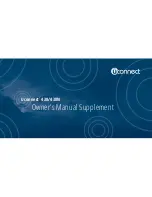
RDL-3000
FAMILY
USER MANUAL
70-00158-03-00
Proprietary Redline Communications © 2015
Page
95
of 254
April 17, 2015
automatically based on current minrate and maxrate settings). These automatic
adjustments ensure interference on a wireless link does not affect the throughput of
other links in that sector. When the uplink or downlink modulation/coding settings are
automatically adjusted below the desired Minimum DL/UL Burst Rate setting, the
downlink PIR for all Services and Service Groups on that link are reduced proportionally
until the condition clears.
For example, in a link operating at 16 QAM 3/4, transient interference may result in a
temporary change to 16 QAM 1/2 to maintain the required PER, and restore the higher
modulation setting after the interference has cleared.
DL Burst Rate
: (Adaptive Modulation disabled) Set the downlink rate for unicast traffic.
The wireless link will be established only at the specified rate. Communicating systems
must be set to operate at the same rate. This rate sets the maximum CIR for the link.
UL Burst Rate
: (Adaptive Modulation disabled) Set the uplink rate for unicast traffic. The
wireless link will be established only at the specified rate. Communicating systems must
be set to operate at the same rate. This rate sets the maximum CIR for the link.
Max. DL Burst Rate
: (Adaptive Modulation enabled) Select maximum downlink UBR
(Mbps) for unicast traffic to this subscriber. This setting sets the upper limit for downlink
modulation and coding.
Max. UL Burst Rate
: (Adaptive Modulation enabled) Select maximum uplink UBR
(Mbps) for unicast traffic from this subscriber. This setting sets the upper limit for uplink
modulation and coding.
Min. DL Burst Rate
: (Adaptive Modulation enabled) Select the minimum downlink UBR
(Mbps) for unicast traffic when adaptive modulation is enabled. This setting is also used
as a threshold setting when Auto Frequency Scan and Scan Threshold are enabled.
Note: When the link is unable to achieve the requested DL burst rate, the DL Unicast
CIR statistics are displayed in
red
on the Subscriber Links screen.
Min UL Burst Rate
: (Adaptive Modulation enabled) Select the minimum uplink UBR
(Mbps) for unicast traffic when adaptive modulation is enabled. This setting is also used
as a threshold setting when Auto Frequency Scan and Scan Threshold are enabled.
Note: When the link is unable to achieve the requested UL burst rate, the UL Unicast
CIR statistics are displayed in
red
on the Subscriber Links screen.
Downlink PIR
: Enter the downlink peak information rate (PIR) for the aggregate
downlink traffic for all Services and Service Groups. When adaptive modulation is
enabled, automatic adjustments to the modulation/coding result in relative changes to
the PIR. The maximum available PIR setting is controlled by the installed options key
(
).
Uplink PIR
:
Enter the uplink peak information rate (PIR) for aggregate uplink traffic for
all Services and Service Groups. When adaptive modulation is enabled, automatic
adjustments to the modulation/coding result in relative changes to the PIR. The
maximum available PIR setting is controlled by the installed options key
(
).
Traffic statistics are reset at the beginning of each common one-second clock tick. If the
maximum throughput is reached before the end of the current interval, that link is
excluded from scheduling additional traffic until the next clock tick.
For example, if a Link transmits its full data allocation in the first 800 ms of the current
metering interval, the Link will not receive any additional bandwidth allocation until the
beginning of the next interval (enforced pause of 200 ms).
Scan Threshold Enable
: (Adaptive Modulation enabled) Check ( ) the Scan Threshold
Enable field to trigger a frequency scan if the wireless uplink or downlink UBR drops
below the Min. DL Burst Rate or Min UL Burst Rate settings. Use the Re-scan interval















































